Double Biquad Antenna
This page contains details on building a double biquad antenna with approx 13dBi gain.
Background
Having experimented with a number of biquad antennas (construction details here), I have found them to be relatively easy to contruct, reliable, and good performers, with about 11 dBi gain.
A number of websites showed a variation of the biquad, with the reflector being double the size, and with the element having twice as many sections.
I decided to make a double biquad, to see how the gain compared to that of a biquad.
Construction
I made a double biquad using exactly the same construction techniques as described on my Biquad Antenna Construction page, except the rear reflector is 110x220mm, and the element is double the size.
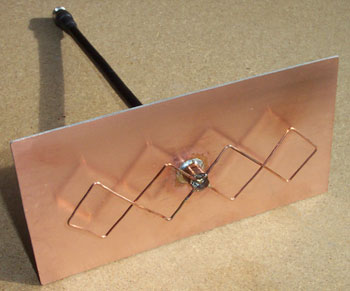
double biquad
Note that the element wires do not touch where they cross over, but are separated with a gap of approx 1-2mm.
To provide some more robustness, and to ensure the element doesn't move, I added some spaces at each end of the element.
The spacers are made from a small section cut from a hollow reticulation riser, and attached to the reflector and element using a small wire tie. Measure and cut the spacers to be 14.5mm long, as this should result in the element being the correct 15mm from the reflector.
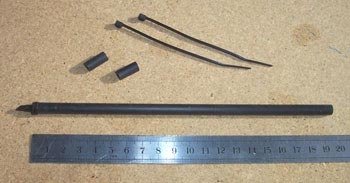
parts required for the spacers
Drill two small holes in the reflector, in line with each end of the element. The holes must be large enough to allow the wire tie to pass through them.
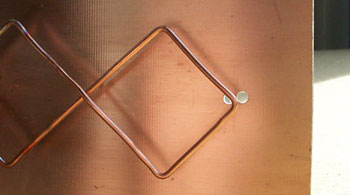
two holes in the reflector for the cable tie
The spacers are attached by passing the wire tie through one of the holes in the reflector, through the tube, looped around the element, and then passed through the tube again, and through the other hole in the reflector.
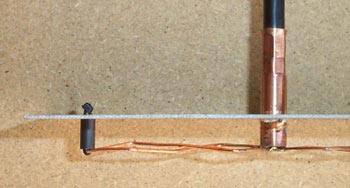
spacer installed
The spacers will ensure the posititioning of the element relative to the reflector will not change, and also means the antenna is less likely to be damaged while in transit or while being handled.
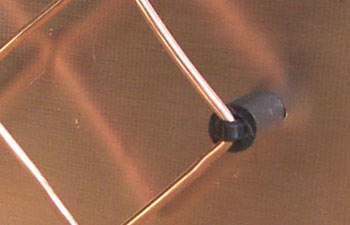
detail of spacer
Note that you can make spacers out of any non-metallic material, providing it does not absorb microwaves.
As with the biquad antenna, if you intend to use one of these outdoors, I'd recommend you place it into a weather-proof enclosure, to prevent corrosion, and to prevent water ingress into the coax.

completed double biquad
Usage
spacer installed
For information on connecting a biquad antenna to a wireless radio, have a look at the page on using wireless antennas.
Testing
To determine the difference in gain between a biquad and the double biquad, some tests were performed, with the signal, noise and SNR recorded.
| antenna | SNR (dB) |
signal (dBm) |
noise (dBm) |
| biquad | 43 | -58 | -101 |
| double biquad | 45 | -56 | -101 |
The test results indicate that the gain of the double biquad is approx 2dBi higher than that of the biquad, which is a significant improvement.
As the biquad has a gain of 11-12dBi, this means the double biquad has a gain of 13-14dBi, so it's a pretty good performer for something that's relatively easy to build.
These results are similar to those obtained by other people who have made double biquads.
Remember that the dBi scale is logarithmic, where 3 dBi is a doubling in gain. An increase in gain of 2 dBi is equivalent to an increase of 60%, which is a worthwhile improvement.
References
Biquad Antenna Construction